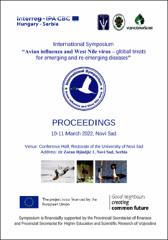Avian influenza - summary results and outcomes in the framework of IPA project Hungary-Serbia (BirdPROTECT)

View/
Date
2022-03-10Author
Lupulović, Diana
Erdélyi, Károly
Balint, Adam
Petrović, Tamaš
Lazić, Gospava
Samojlović, Milena
Gajdov, Vladimir
Pajić, Marko
Knežević, Slobodan
Đurđević, Biljana
Vidanović, Dejan
Rekecki, Tibor
Mirčeta, Jovan
Lazić, Sava
Metadata
Show full item recordAbstract
Avian influenza viruses type A (AIV) have zoonotic potential with the negative
impact on birds and human health worldwide. Based on their molecular
characterization and upon the severity of clinical signs in poultry, avian
influenza viruses are classified into: highly pathogenic avian influenza (HPAI)
and low pathogenic avian influenza (LPAI) viruses. Wild birds are the natural
reservoirs of LPAI in nature, primarily aquatic birds. AIV often mutates in
nature causing new flu A subtype. New viruses can endanger not only wild
birds but also represent the risk for human population. The aim of this study
was to investigate the presence of AIV in various wild birds in the water
habitats in Serbia and Hungary and their importance in virus dissemination in
the region.
In total, 1347 samples from wild birds were collected in both countries. Out of
this number, 600 samples belonging to 55 species originated from Serbia, while
747 specimens were obtained from 58 different kind of birds in Hungary. InVojvodina Province, in 15 out of 600 samples (2.5percent, 15/600) was detected the
presence of AIV RNA. The AIV genome was identified in two waterfowl bird
species collected from 9 different locations. No positive AIV specimen was
detected in Hungary. Based on the obtained results, Risk assessment and
Feasibility study will be created to estimate the risk for human health. This
research was conducted within the project “Protect wild birds = protect habitats
= protect humans” (BirdPROTECT) of cross-border cooperation IPA program
Hungary-Serbia.
